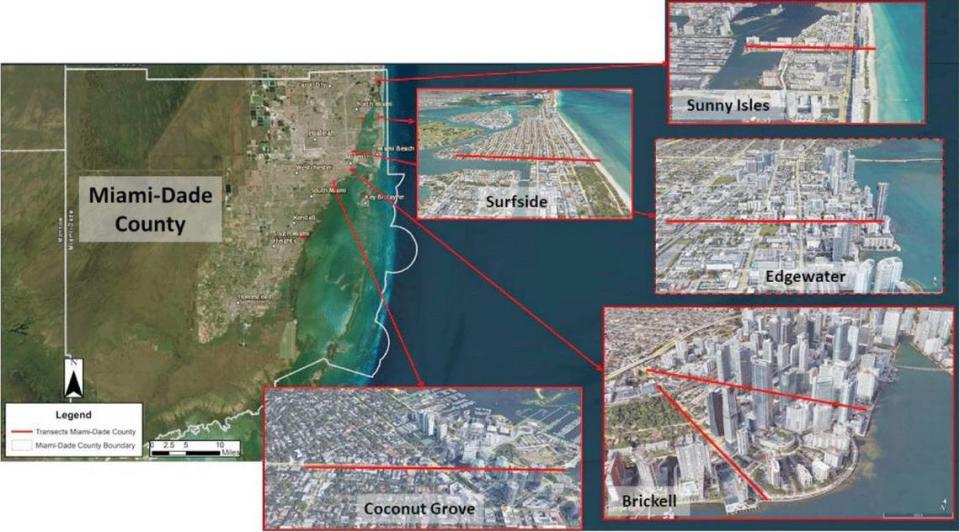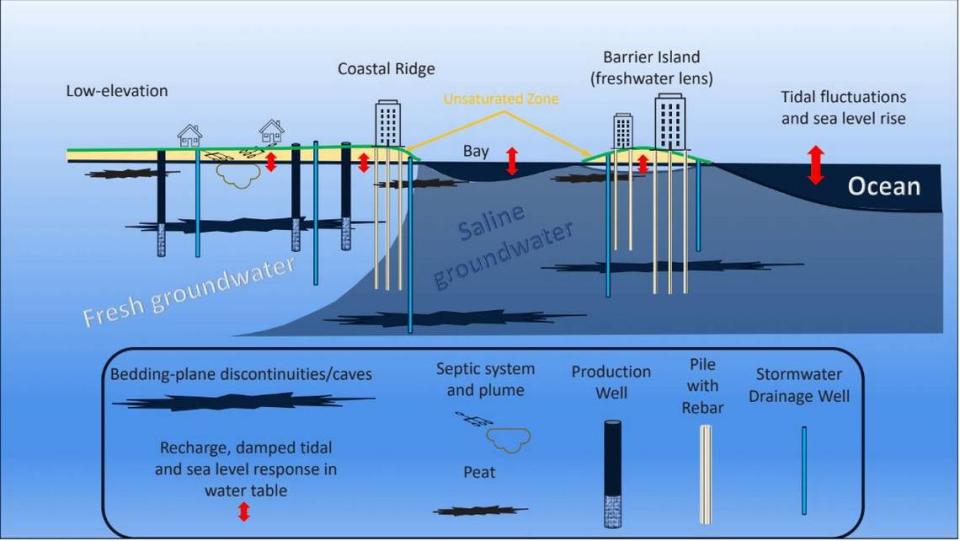Could sea rise weaken Florida’s coastal buildings? New study will help answer question
When the Champlain Towers building in Surfside came crashing down in 2021, the tragedy raised concerns about the threat of rising groundwater possibly destabilizing thousands of older buildings that crowd South Florida’s coast, and the underground foundations that keep them standing.
While the investigation later turned away from a saltwater-eroded foundation as a trigger for the disastrous collapse, researchers still have unanswered questions about the potential threat posed by sea level rise to the pipes, wires, steel and concrete that undergird South Florida.
Now, thanks to a $9 million federal grant, scientists hope to get a detailed look at the murky mystery underneath our feet. Florida International University plans to use that cash to fund a network of wells along the coast that could offer new insight into exactly how sea level rise is already changing the landscape underground — and what kind of threat the thousands of high rises along the coast could face.
Congresswoman Debbie Wasserman-Schultz, who secured the $9 million in federal funding for this project, called this research crucial to the future of South Florida.
“Getting this data and investing in this kind of research is going to be critical to ensuring we have a continued place to live,” she said in a press conference Wednesday morning in Hollywood. “For us here in South Florida, these challenges aren’t just a someday thing, they’re a right now thing.”

South Florida sits on a base of porous limestone rock, akin to a sponge cast out of concrete. When sea levels rise along the coast, they also rise under our feet, pushing water close to the surface. The region expects to see about two feet of sea rise by 2060, and there are some spots in Miami-Dade with less than three feet of dry dirt before you hit groundwater.
That means, if sea level rise is left unchecked, there will soon be pockets of South Florida where that groundwater meets the surface all the time, leaving the spot permanently inundated.
Until then, the other big worry is how all of the underground stuff is faring in increasingly wet and increasingly salty conditions.
READ MORE: Threat from below: Sea rise is pushing up groundwater — and flood risks for South Florida
Research has already shown that rising groundwater levels are rendering septic tanks unusable along the coast, and Fort Lauderdale has noted that rising groundwater levels have contributed to the early degradation of its underground sewage and water pipes.
But the Champlain Towers collapse brought the question of sea rise’s impact on building foundations to the forefront.
The foundation piles under Champlain Towers, and many others in South Florida, were built 40 years ago to withstand only the occasional soak when groundwater rose, even though they reach hundreds of feet into the ground. Now that sea levels are higher, the concrete and steel foundation piles are exposed to the degrading effects of saltwater more often. And yet, researchers found, there is little research on this phenomenon and no government agency officially charged with watching for this kind of trouble underground.

“After Surfside, we wanted to look for information that could be pertinent, but we couldn’t find anything at all, and that was worrying,” said Mike Sukop, a hydrogeologist at FIU and head of the newly funded subsurface groundwater monitoring network.
“It’s a data gap,” he said. “Given our circumstances here in South Florida, I don’t think we can afford a data gap. The stakes are too high.”
While the threat of rising groundwater was initially considered as a potential cause for the condo collapse in Surfside, including in a section of the Miami-Dade grand jury report on the collapse, investigators and reporting by the Miami Herald have found it unlikely that underground corrosion was a trigger for the tragic collapse.
Now that funding is in place, Sukop and other researchers are ready to start the planning and permitting process to drill the proposed 150 or so monitoring wells along the barrier islands and nearshore coast of Miami-Dade, Broward and Palm Beach County.

This new coastal subsurface monitoring network will help researchers across South Florida better understand the risks to underground infrastructure, track and predict flooding on rainy or high-tide days and model how rising seas could impact South Florida’s drinking supply.
Dorothy Sifuentes, director of the U.S. Geological Survey’s Caribbean-Florida Water Science Center, said the USGS has a network of groundwater monitoring wells already, but they’re focused on watching South Florida’s drinking water for signs of saltwater, so they’re inland and far from the coast.
“This work is going to complement our network very nicely,” she said. “Having that coastal component will really help expand that picture.”

